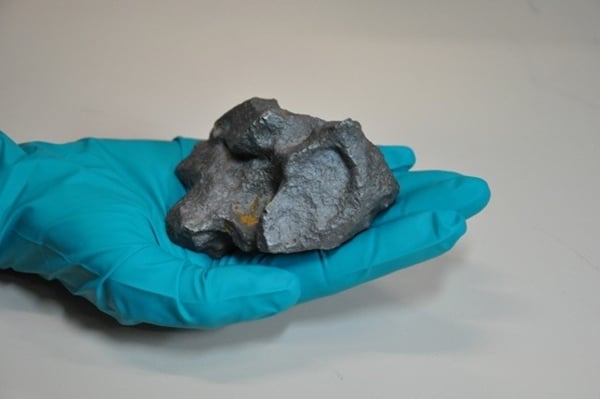Art & Exhibitions
Meteorite Sculpture Will Be International Space Station’s First Artwork
A space rock returns to the heavens.

Photo: Courtesy James Cohan Gallery, New York.
A space rock returns to the heavens.

Sarah Cascone

When the latest supply mission to the International Space Station (ISS) launches tomorrow, July 29, there will be some unusual cargo aboard: a meteorite sculpture by Katie Paterson, which will become the ISS’s first artwork.
Along with with propellant, water, and air, the artwork, titled Campo del Cielo, Field of the Sky (2012), and other dry cargo will be transported by the Georges Lemaître ATV, an unmanned spacecraft, launching from Kourou, French Guiana, at the Guiana Space Centre.
The piece looks indistinguishable from an authentic meteorite, and for good reason. Paterson used the real deal as her source, creating a cast of a portion of a real 242-pound meteorite, then melting down the original at a scorching 1,700 degrees Celsius and recasting it in the exact same shape, turning the original into a copy of itself.
The original space rock is thought to be some four and a half billion years old and to have landed on the planet about 5,600 years ago, in Argentina’s Formosa province. By journeying aboard the ISS, the meteorite will be returning to the heavens from whence it came.
“The iron, small rocks, metal, and dust inside becomes reformed,” Paterson said in a press release put out by her representatives at New York’s James Cohan Gallery, “and the layers of its cosmic lifespan—the warping of space and time, the billions of years of pressure and change, formation and erosion—become collapsed, transformed, and renewed.”
Paterson created a similar meteorite work that was displayed during the 2012 Olympic Games in London, having being commissioned for the Exhibition Road Show by London’s Kensington and Chelsea borough. The artist always intended to have one of the works in her meteorite series return to space, and now, thanks to the European Space Agency (ESA), Paterson’s vision will become a reality.
“By sending it ‘back to space,'” Paterson explains, “I hope to fire the imagination of students, youth—anyone really—and foster a discussion on our relation with the wider universe.”
Before Campo del Cielo could punch its ticket into space, however, the sculpture, like any good astronaut, had to undergo a year of exhaustive testing and preparation. The ESA was concerned that rust on the meteorite’s surface could be become lodged in air filters, endangering the astronauts’ health, and that the astronauts might risk cutting themselves on the work’s sharp edges.
One proposed solution was keeping the piece tightly sealed in a zip-lock bag—unsightly, but effective. Instead, the ESA opted to coat the sculpture in a clear varnish composed of non-toxic, space-grade silicon. The authors of the ESA blog were surprised to find themselves responsible for such a unique task, reflecting, “who would have thought we would be so deeply caught up in an interplanetary art project?”
The process of preparing the space rock for a second extraterrestrial flight involved cleaning away corrosion and dust, and vacuum heating the sculpture to 100˚ Celsius to ensure there is no moisture on its surface before the protective coating is applied. After baking (recipe here), the meteorite was officially ready for takeoff, and to go where no artwork has gone before: to the ISS.
The Georges Lemaître launch will be available to watch live July 29 at 11:44 p.m., GMT.